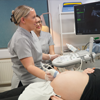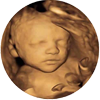No two women’s labour experiences are the same. Nobody can guess what your labour will be like, or how long it will last. However, you can do some things to prepare yourself.
The Stages of Labour
Labour progresses in three stages:
Stage 1: When contractions gradually open up the cervix, which is the neck of your womb (uterus). It consists of early labour, active labour and the transitional phase.
Stage 2: When you push your baby out into the world.
Stage 3: When you deliver the placenta.
There is also a phase that happens before the first stage of labour, called the pre-labour.
Pre-Labour: The Facts
During pregnancy, your cervix is closed and plugged with mucus, to keep out any infection. Your cervix is long and firm, giving a strong base to your womb. It’s also in a position that points slightly towards your back.
Before labour can start properly, your cervix has to go through some changes. It has to move forward, soften and shorten. The softening of your cervix is often called ripening.
The First Stage of Labour
In the first stage of labour, your cervix has to open (dilate) so that your baby can be born. The muscles of your womb tighten with each contraction and then release, gradually drawing your cervix up you cervix into the lower section of your womb.
In the early phase of first stage labour, your cervix may open very gradually so that it may seem as if no changes are happening at all. Early labour can be slow and your contractions may not last for long and have lengthy gaps between them. They may even stop for a while before starting again.
As you enter the active phase of first stage labour, the contractions usually last longer and become more frequent and powerful. Towards the end of the first stage, your labour may become much more intense. This phase of labour is called transition. By the end of the first stage, your cervix will be fully dilated and open to about 10cm in diameter.
The Second Stage of Labour
This is the stage when your baby is born. During the second stage of labour, your baby will descend into your vagina (the birth canal) and you’ll push your baby down and out to meet you and your partner for the first time.
You’ll feel the pressure of your baby’s head low down in your pelvis, and with each contraction, you may feel strong urges to bear down. Listen to your body and push in response to the urges. Take a few breaths between pushes if that’s what feels right for you.
With every push, your baby will move further through your pelvis, but at the end of the contraction, they’ll probably slip back a little again. This is normal and gives the muscles of your pelvic floor time to stretch gradually. As long as your baby keeps gradually moving down, you’re doing fine.
When your baby’s head is visible at the entrance to your vagina and stays there when the contraction has ended, it’s called crowning.
Your midwife will tell you when she can see your baby’s head, and may ask you to stop pushing and blow or sigh our your breaths. This helps you to resist the urge to bear down for two or three contractions, so that your baby is born gently and slowly.
Taking this approach may help to protect your perineum (the area between your vulva and your anus). You’ll probably feel a hot, stinging sensation, as the opening of your vagina starts to stretch around your baby’s head. Your midwife may use warm compresses to support your perineum as it stretches to help to prevent a tear.
Once your baby is born, they’ll be dried off with a clean towel and then be placed onto your tummy or chest for skin-to-skin.
The Third Stage of Labour
The third stage of labour starts when your baby is born, and ends when you deliver the placenta and the empty bag of waters that are attached to the placenta. These come away as your womb contracts down after the birth.
Your contractions will be noticeable but weaker when they begin again. The placenta will peel away from the wall of your womb and move down the birth canal into the vagina. You may get the urge to push when this happens.
It’s routine to be offered an injection for the third stage that helps your womb to contract down and the placenta to come away. This may cause side-effects such as nausea and vomiting because of the drugs used. You won’t have to do any pushing, as once it’s detached, your midwife will gently pull out the placenta.
If all went well in your pregnancy and labour, you can choose to have a natural third stage. This is when you deliver the placenta without an injection. Upright positions, skin-to-skin contact with your baby and starting to breastfeed your baby may all help to stimulate contractions to help you to deliver the placenta.
Whether you have a natural third stage or have the injection, it’s recommended to wait at least a few minutes before clamping the cord which will benefit your baby. While all this is going on, you’re likely to be cuddling and getting to know your newborn better.













 Packages & Prices
Packages & Prices  Important Info & Policies
Important Info & Policies  Your Scan
Your Scan